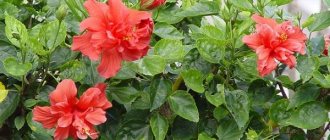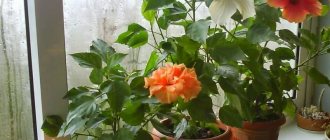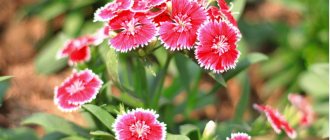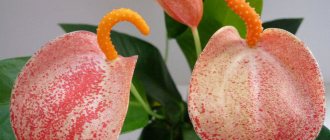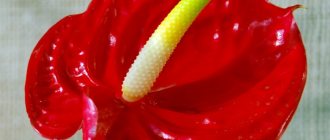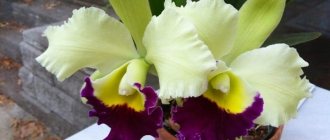Hibiscus - propagation and rooting at home
Hibiscus, or China rose, is not as easy to propagate as compared to other indoor flowers. It is usually bred by cuttings, but some gardeners prefer growing the flower from seeds. We will tell you in detail about each of these methods of propagating hibiscus and determine their advantages and disadvantages.
Advantages and disadvantages of cuttings
Cuttings are a vegetative method of plant propagation. This method is quite simple, even a novice gardener can do it.
Another important advantage of this method is the fact that hibiscus grown from cuttings will delight you with flowering within a year, while retaining all the varietal characteristics of the mother plant (flower color, its doubleness).
The root system formed by cuttings is stronger and more powerful than those plants that were propagated by other methods, for example, by seeds (read about how to grow indoor hibiscus from seeds, as well as further care for the flower after planting).
You can learn in detail about the propagation, planting and further care of hibiscus in the home and garden, as well as see a photo of the flower here.
What time of year is it best to propagate the plant?
The best time to take cuttings is from April to August. Experienced gardeners recommend rooting in May, since it is in this month that the plant is most active: new cells appear and develop, all metabolic processes proceed at an accelerated pace. If the hibiscus is rooted in the last month of spring, then the probability that the plant will take root will be close to 100%.
Cuttings can be carried out in winter, but the rooting process will be slower and it will not always be possible to achieve a positive effect, since in winter there is no lighting or temperatures that the shoot needs.
Can it be propagated by leaves?
A hibiscus leaf cut and placed in water can produce roots. Planted in the ground it will be green and beautiful in appearance. It is not recommended to use the leaf for propagation: a full-fledged plant will not appear from it.
If you use a leaf with a heel for propagation, then this will already be considered a cutting, it will take root well and over time will turn into a full-fledged plant.
: Syrian hibiscus - planting and care, growing rules
How to care for hibiscus
Hibiscus love abundant watering and do not tolerate drying out of the earthen clod - then their leaves immediately droop. But they don’t like the bay either; plants can die from excess moisture. In winter, watering is reduced.
It is better not to leave water in the pan. The acceptable temperature for keeping the flower is from 7 to 30 degrees, but in extreme heat it should be placed in the shade. To lay flower buds, the plant needs a temperature of 15 degrees Celsius.
When placed in a light location, hibiscus bloom much better than in the shade. These plants can withstand even direct sunlight and are even desirable for flowering (about 5 hours a day).
They can bloom all year round if there is enough lighting, but they also produce buds far from a light source (usually only 1-2).
The classic Chinese hibiscus flower lasts only 1 day, but the Florida hybrid can last up to 5, depending on the variety.
Often, hibiscus can suffer from various diseases or pests. We'll tell you how to deal with them here.
To propagate Chinese roses use:
- seeds;
- cuttings;
- dividing the bush;
- layering.
Propagation by seeds
After the plant's bud withers, seeds appear. To grow hibiscus from seeds, they require preliminary preparation for sowing.
You need to pour water into a container, add a root formation stimulator and soak the seeds for 12 hours.
After this, rinse them, degrease them in a weak solution of potassium permanganate, place them in a damp cloth and leave them in a warm place.
After the sprouts appear, moisten them with water and ventilate. Plants planted in pots quickly produce new shoots. It begins to bloom after 3 years; with this method, the properties inherent in the original species are not always preserved.
How to grow from cuttings?
Decorative hibiscus is distinguished by a variety of colors; they reproduce easily if certain conditions are met. When propagating by cuttings, it is necessary to properly root the cutting from the plant you like. When choosing petioles, remember that it must have at least two internodes.
To root cuttings, you can use several methods:
Methods for propagating indoor and garden plants
If you have an adult plant at home, you can propagate it if you wish in several ways :
- seeds;
- division;
- layering (suitable only for garden plants);
- cuttings.
The first three options are the longest. When propagating by seeds, you will first need to wait for the seed to ripen, then you will need to collect it, prepare it, plant it, and take long and persistent care of the seedlings, providing them with almost greenhouse conditions for growth.
It is most convenient to propagate hibiscus using cuttings . This is the fastest and easiest option for propagating indoor and garden plants.
How to propagate by cuttings?
Cuttings are the most convenient and easiest way to get several young seedlings from an overgrown adult hibiscus that will have identical flower colors. The ideal choice of planting material would be young, semi-lignified shoots. They will allow the grower to plant the mother plant in as many planting containers as he wants.
But before you start planting, pay attention to the condition of the cuttings . An absolutely healthy bush will have shiny, bright, juicy foliage. Neither the leaves nor the stems should have any defects, dark spots, or plaque.
The presence of at least one of the listed symptoms indicates that the hibiscus is sick with a fungal or other disease. Such a bush is not only dangerous to cut, it cannot even be brought near other flowers, as it is a source of infection.
If you notice that the edges of the leaf blades of plants have turned yellow, dried out, or have become sticky, then immediately stop propagating such a plant, put it in quarantine and begin treatment.
Reproduction of elite plants
There are many varieties of hibiscus. Among them there are plants with double flowers. Also with unusually beautiful colors and shapes, which differ significantly from ordinary culture. In view of such diversity, many gardeners have a question about how to root varietal hibiscus. You'll have to be patient here. The fact is that elite specimens produce root shoots much longer than classic ones. Sometimes this process drags on for six months.
It is best to root varietal hibiscus in water. Three basic conditions are required: heat, light and sufficient air humidity. Ziploc bags can be used as a material to create a greenhouse effect. With such a device you will not have to constantly disturb the seedling. It will be enough to simply open the bag once a week and release excess moisture from it. A light coating (callus) will first appear on the part of the cutting that is in water; after a while, roots will gradually begin to grow.
Cuttings of herbaceous hibiscus
Herbal hibiscus is a hybrid variety; cuttings can only be taken in early summer when shoots are growing. This way, before the first cold weather, the seedlings will have time to take root and the likelihood that the flower will survive the winter increases.
In order for cuttings to be successful, it is recommended:
- On the day of planting, in the morning, water the bush generously so that the water saturates the earthen ball. In the evening, you can proceed directly to separating the sprouts. It is recommended to choose young shoots that grow at the base of old bushes;
- Do not cut out the shoot, but pull it out to the side. The result should be a seedling with root rudiments or a white tint at the base;
- Cut off the top of the sprout, leaving some foliage;
- The base of the seedling is sprinkled with root;
- The hole for a new bush should be filled with a mixture of brown high peat, sand and charcoal. The mixture must be poured thoroughly;
- The cuttings are planted and covered with a cut bottle on top until rooting. There is no need to water additionally;
- It is recommended to remove the bottles for a few minutes every day. If it’s hot outside, you should additionally spray the seedlings;
- After two and a half to three weeks, rooting occurs. Now it’s time to start acclimatizing the seedling. To begin with, it is recommended to open it every day for ten minutes, gradually increasing this time, hardening the hibiscus. On average, complete adaptation to new conditions occurs within a week.
If the resulting plant seems weak at first, it can be tied to a stake. In this case, it is better to take a longer peg, for several garters.
Reproduction of hibiscus at home is a painstaking task, but does not require phenomenal knowledge.
We invite you to watch a video about the propagation of herbaceous Syrian hibiscus by cuttings:
All it takes is desire, attentiveness and a few hours of free time to get several from one beautiful flower and then, perhaps, a whole greenhouse that will please the eye.
Rules for planting cuttings in the ground
Either cuttings without roots or previously sprouted roots are planted in the ground in containers with water. In both cases, the soil should be well moistened and enriched with nutrients. You should not water your hibiscus too often. He loves water, but does not tolerate it stagnating at the roots.
During the summer months, it is recommended to use interval watering. To do this, alternate abundant irrigation with moderate irrigation until the earthen clod dries completely. This is one of the easiest ways to spur a plant into active growth and flowering. When watering abundantly, fertilizers must be added to the water.
Planting hibiscus cuttings in the ground
From November to February the plant is dormant, so it does not need intensive watering. At this time, the soil should be moistened only when it dries well. For control, you can have a wooden stick on hand. If, when you stick it into the ground from the edge, the soil does not stick to the tree, then you can water it.
Important! Nitrogen fertilizers are not suitable for hibiscus; they do not cause either active growth or flowering.
The optimal time for the first feeding is the second half of March. Potassium-phosphorus fertilizers are added to water for irrigation. Subsequent feedings are carried out 1-2 times a month, giving preference to complex mineral fertilizers for indoor flowering plants.
The young plant will need to be replanted every year into a new, slightly larger pot for the first 3 years. Then the transplant is done much less frequently - after 2-3 years. The main attention is paid to the formation of the correct crown. It is necessary to remove all shoots growing upward, as well as those that thicken the bush and grow inside its crown.
This is how you can easily and simply propagate hibiscus and grow it into a stunning flowering bush. Even novice flower growers should not have any problems.
4 5 votes
Article rating
Is it possible to plant a shoot in open ground?
Chinese rose is a heat-loving plant and is not suitable for our climate. With the exception of garden hibiscus, adapted for temperatures down to -30 degrees. The place for the plant is chosen to be bright and protected from the wind. The soil should be light and nutritious, water should penetrate deeply.
Planting is carried out in the spring, when the soil is well warmed up. Pit preparation:
- The planting hole should be twice as deep as the hibiscus root system.
- A drainage layer 15 cm thick of broken brick is laid.
- The next layer is 10 cm thick of sand.
- Compost layer 15 cm.
- The last layer is sandy, 15 cm deep.
Nutrient soil for planting is prepared:
- 2 parts of soil from the pit;
- 4 parts peat;
- 1 part sand.
A seedling is placed in the prepared hole so that the neck is slightly covered, and it is covered with prepared soil.
How to propagate Chinese rose at home
The beauty of hibiscus always delights, and the splendor of colors pleases the eye. The Chinese rose, as this plant is also called, is found in almost every home. Under natural conditions, hibiscus reproduces by its own seeds. At home, most often, this process is carried out vegetatively using cuttings.
Chinese rose
With the arrival of spring, every amateur gardener strives to put his plant collection in order. A special place is given to reproduction, and any gardener needs to know how to do this at home.
At home, you can use both methods of propagating ornamental hibiscus:
- The seed method, in which hibiscus seeds are placed in the soil.
- The vegetative method is by cuttings, which must first be rooted.
Features of cultivation
Failure to comply with certain nuances can lead to the plant looking lethargic and ultimately dying. In the end, all your hard work will be in vain.
It is important not only to successfully carry out the rooting process, but to continue to take care of this wonderful flower. To constantly admire the blooming of the Chinese rose, you need to create an optimal atmosphere for it
She does not like too dry air, so it is better not to place the flowerpot with the plant near the radiator. To avoid flower wilting, spraying procedures must be carried out.
You should not choose a pot that is too wide for replanting the plant. They seem to feel the size of the container and stop developing intensively - the smaller the flowerpot, the more buds there will be on the bush
It is important to understand here that the roots of the plant should not be left with too much space. They also do poorly in plastic containers.
Chinese roses bloom for a long time.
The plant needs to be fertilized starting in March. This should be done once a week. To maximize the absorption of nutrients, you need to alternate the application of fertilizers - first feed the crop with a mineral complex, and in the next application add organic matter.
It is important to regularly wipe dust on the leaves or carry out hygiene procedures by spraying. It is also necessary to protect the bush from direct sunlight.
You especially need to pay due attention to culture if you have centralized heating, where the air is usually too dry. All care activities should be carried out in moderation
Required care for Chinese rose
Caring for Chinese roses is required at a young age and during the flowering period.
These two steps will ensure the healthy growth of your beautiful plant. Caring for a transplanted cutting involves the formation of a crown. As soon as the planting material has completely taken root and began to rapidly gain height, it should be pinched. Only in this case will the Chinese rose grow lush and blooming.
Caring for hibiscus during flowering:
- providing a sufficient amount of sunlight (but not direct sunlight on the leaves of the plant);
- fertilizing the soil;
- watering with warm water;
- spraying.
You can use homemade weak sweet syrup as fertilizer.
This requires one teaspoon of sugar and 250 grams of warm liquid. Mix the ingredients until completely dissolved. In the summer, when the heat sets in, it is advisable to take the hibiscus (Chinese rose) out onto the balcony. Place it in a corner where there is no direct sunlight, but there is good daylight. These conditions will ensure abundant flowering.
The Chinese rose is a “water plant”. Watering in summer should be done frequently. You can do it every day – morning and evening. Also, the flower should be sprayed.
Pruning shoots has a beneficial effect on the growth and flowering of Chinese roses. You need to inspect the bush and identify weak branches. They are cut off first, leaving only a shoot two centimeters long from the buds with leaves. The crown is also trimmed to make the flower decorative. If you trim the shoots correctly, the plant will be lush and well-formed.
Chinese rose diseases
Improper care of Chinese roses can lead to diseases.
The most common diseases of Chinese rose:
- fungal infection;
- spider mite;
- aphid;
- felt
Symptoms of a fungal infection: blackening of leaves and falling buds.
To avoid this disease, you do not need to over-moisten the soil, and also avoid drafts and sudden changes in temperature. Aphids and felt insects spread due to dry air and improper watering.
Cuttings: how to root cuttings?
To propagate Chinese roses by cuttings, you can use the material remaining after pruning the bushes. How to take a shoot correctly? A young, non-woody cutting 8-12 cm long, with at least three internodes, preferably cut in January-February, is selected. There are two types of planting - in water and directly in the ground.
Instructions for planting Chinese rose cuttings in water:
- A vessel, preferably made of dark glass, is filled with water.
- A cutting is placed in it.
- The top is covered with a cap, glass jar or plastic container to increase humidity.
- The cuttings take root in a month.
- After the roots appear, the plant is transplanted into the ground.
Reference! For a young plant, adding sphagnum moss to the soil is very beneficial.
Instructions for planting Chinese roses directly into the ground:
- Half of the leaves are removed from the cuttings.
- A 0.5 liter pot is prepared - washed and doused with boiling water.
- Before planting, the soil is spilled with boiling water.
- Drainage is placed at the bottom, the pot is filled with loose, water- and breathable soil.
- The cutting is buried 1.5-2 cm in moist soil.
- Cover the top with a jar or put on a bag (mini-greenhouse conditions are created).
- The pot with the plant is placed in a bright place with a temperature of 23-25 degrees, but not in direct sunlight, and is not moved from place to place.
- If condensation appears, ventilate.
- The cutting begins to grow - increase the ventilation time; if the hibiscus does not drop its leaves, remove the greenhouse.
Propagation of hibiscus by cuttings preserves varietal characteristics, and the plant blooms in the first year.
We invite you to watch a video about cutting hibiscus:
Read other articles about hibiscus on our website:
- Why is it considered the “flower of death” and is it true that it cannot be kept in the house?
- Decorate your garden - Chinese rose Angel Wings.
- Why doesn't hibiscus bloom at home?
Ways to stimulate rooting
How to propagate Chinese rose
You can help the cutting grow roots using folk remedies, as well as specialized preparations. Grandmother's proven remedies include:
- Willow water. It is enough to place several young willow branches (up to 6 mm thick) in a container with water and wait for their roots to appear in order to obtain the ideal solution for rooting hibiscus cuttings.
- Honey. Add 1 teaspoon of honey to 1.5 liters of water. The cuttings are soaked in this solution for 12 hours, after which they are placed in clean water, where they will take root as usual.
- Knowing how to propagate outdoor hibiscus from cuttings, you can easily root a branch from any bush you like. Potatoes are used to propagate garden (herbal) hibiscus. The ends of the cuttings are stuck into it and buried together with the tuber in the ground. Potato nutrients will nourish the young bush for a long time.
Ways to stimulate hibiscus
Among the drugs that can be purchased in the store, the following have proven themselves to be effective:
- Kornerost (heteroauxin) is a phytohormonal agent with high activity. Its use helps not only speed up the process of root formation, but also the survival rate of the cuttings after planting. The working solution is prepared in the following proportion: dilute 50 mg in 1 liter of water. It can be used for soaking cuttings immediately after cutting, as well as for subsequent watering.
- Kornevin is a biostimulant with the widest spectrum of action. The powder is diluted in a proportion of 5 g per 5 liters of water. The prepared solution is used for soaking cuttings for a day, as well as for watering after planting.
- Zircon is the safest root formation stimulator, harmless even to bees. Sold in ampoules. According to the instructions, the product is diluted in water and the cuttings are kept in this solution before rooting. In the future, the product can be used for feeding, diluting it in water in a proportion of 1 ml per 1 liter of water.
A beautiful and useful garden inhabitant
Typological features of the plant include:
- large double, semi-double flowers, reaching a diameter of 20 cm;
- petiolate leaves with serrated edges;
- bright color of the corolla;
- the fruit is a five-leaf capsule filled with small seeds.
Pan-Asian countries are considered the birthplace of hibiscus. In this regard, the plant received its second name - Chinese rose. Like other mallow Chinese roses:
- moisture-loving;
- sun-loving;
- prefer light, sandy soils;
- need nitrogen and phosphorus baits.
It is worth noting that hibiscus flowers and leaves have medicinal properties. A decoction of the buds is used to treat patients with dysentery, hemorrhoids, inflammatory diseases, and stomach ulcers. Acidic enzymes contained in the petals stimulate the production of bile and the removal of poisons from the body. Decoctions based on dried buds and alcohol lotions from corollas soothe inflamed skin, reduce irritation and help prevent acne.
Hibiscus tea is long tea with the addition of Sudanese rose petals (a type of garden hibiscus), which stimulates appetite, lowers blood pressure and is an effective immunomodulator.
The collection of inflorescences is carried out during the active growing season - from May to October. During drying, the buds are not disassembled into petals, but placed in a shaded, well-ventilated place. Decoctions of hibiscus are used to rinse hair, wipe the skin of the face and neck, and also fill healing phyto-baths.
Further care
Young shoots of Chinese roses are cared for in the same way as adult plants. When the rose grows, remove the old stems, leaving new ones. Weeds are removed and the soil is loosened. Feeding is needed during the period of active growth, from June to September. The fertilizer must have a high phosphorus content. In the fall, potassium mixtures are added to prepare the hibiscus for wintering.
The Chinese rose is a spectacular and unpretentious indoor plant, which is also easy to propagate. The shape of the bush can be varied by pinching. Hibiscus will decorate any home with its large flowers.
0 0 votes
Article rating
Types of plants and their description
In its homeland, hibiscus is called the flower of love, where it is a symbol of beauty and femininity. In Hawaii, local girls decorate their hair with these bright flowers on holidays. The plant belongs to the Malvaceae family, which is quite numerous. Hibiscus grows as:
- ornamental trees;
- herbaceous varieties;
- subshrubs;
- bushes.
Inflorescences can be funnel-shaped, double or simple. Regardless of the shape, they all have an exotic, attractive appearance. There are yellow, crimson, purple, lilac, and white colors. There are also two-color varieties. Tree hibiscus, grown in standard form, looks great as a tapeworm.
Low-growing varieties are suitable for placing in borders. Herbaceous hibiscus harmonizes with ground cover roses and plants with decorative leaves. Garden hibiscus begins to bloom at the end of June, flowering ends at the beginning of October. Frost-resistant varieties can withstand significant temperature drops (down to -20°C).
Popular varieties
Since there are several varieties of hibiscus suitable for the garden, you can choose the one that suits your taste. The most popular types are:
- Syrian hibiscus, also called garden hibiscus. It grows as a neat bush up to 3 meters high. Opened inflorescences resemble saucers. Flowering begins in July and continues until autumn. There are varieties with simple and double flowers in white, red and pink. In winter, this species can withstand temperatures down to -25°C. In summer it needs warm weather to bloom. Prefers neutral soil and places illuminated by the sun.
- Hibiscus double or variable. China is considered the birthplace of the plant. Powerful shrub growing up to 3 meters in height. Can be grown in standard form. The inflorescences are pale pink in color. The flowers are often double, but simple ones are also found. The diameter of the blossoming buds reaches 10 cm. When grown as a bush, it requires only sanitary pruning and forms independently.
- Herbaceous hibiscus. A plant with powerful, erect shoots up to 3 m high. Large leaves are shaped like sunflower foliage. The color of the inflorescences is pink, crimson, white. This variety of “flower of love” prefers warmth and sunlight. Blooms from August to early autumn. Almost any soil is suitable for this plant. It is considered unpretentious and frost-resistant. In autumn, it is recommended to cut off the entire above-ground part of the hibiscus. Flowering next year will occur only on new shoots.
- Swamp hibiscus. A versatile perennial that can be grown both in the garden and at home. Its large scarlet inflorescences look like rose flowers. There are black specks in the middle of each bud. This is the most frost-resistant species; in winter the plant can withstand temperatures down to -30°C.
There is a place for any type of hibiscus in the garden. Its herbaceous forms allow you to create picturesque compositions, while tree-like varieties are suitable for constructing hedges.
Substrate preparation
We figured out how to root indoor hibiscus cuttings. Next, let's move on to preparing the soil in which the flower will grow constantly. It would be good to purchase a special composition for citrus crops and add a little sand and vermiculite to it. You can prepare the substrate yourself. For this purpose, you need to take: three parts each of leaf and turf soil, one each of humus, charcoal and sand. If these proportions are observed, hibiscus usually develop well, get sick less and live long.
The Chinese rose also feels most comfortable in peat soil. Experienced gardeners advise adding sphagnum moss to it to regulate humidity.
Seed propagation of hibiscus
This method is suitable for growing valuable varieties of hibiscus and for obtaining new ones through crossing. The long period (several years) that passes from sowing to the moment of flowering makes propagation by seeds uninteresting for ordinary lovers of indoor floriculture. Seed material can be purchased in specialized stores or obtained at home by pollinating flowers with a soft brush. If pollination is successful, the flower calyx does not fall off after a few days, but remains on the plant. Hibiscus seeds ripen in a five-seed box for a month.
It is advisable to soak the seed material in a solution of any stimulant (Epin, Humate, etc.), diluted according to the instructions, for several hours. Place the prepared seeds in a damp cloth and wrap in cling film or a bag. At a temperature of about 25-30°C, the seeds begin to hatch within 3-5 days. Without waiting for a long root to grow, they need to be sown in moist soil, prepared as indicated above, for planting cuttings. The seeding depth is 0.5-0.7 mm. The container with seeds must be covered with glass or film to retain moisture. In a warm place, seedlings will appear in 7-14 days.
After the formation of 1-3 true leaves, plant the seedlings in separate pots with a diameter of 5-7 cm. Planting and care are carried out according to the rules common to all young plants:
- It is best to water from a tray, avoiding stagnation of liquid in it;
- do not cool containers with seedlings below +20°C, as this can cause the disease “black leg”;
- Seedlings should not be left in direct sunlight and should not be allowed to dry out.
Growing hibiscus seedlings need to be transferred as the roots fill the volume of the pot. In good conditions, they grow quite quickly, and young bushes propagated vegetatively can even bloom by the end of the 1st year of cultivation.
Sprout care
After a few days, the seeds will hatch and small sprouts will appear. The mini-greenhouse needs to be ventilated every day, and the sprouts should be sprayed with warm water. Maintain the temperature at 22–27 degrees. As soon as 2-3 leaves appear, the plants need to be planted in small pots. Take soil consisting of humus and turf soil in equal proportions. A commercial mixture for seedlings, which consists of peat with the addition of sand and ash, is also suitable. Seedlings need to be shed with a solution of foundation in order to avoid fungal disease - “black leg”. It is important to maintain moderate watering and diffused light.
The question is off topic. Question about dachas
We are constantly receiving letters in which amateur gardeners are worried that due to the cold summer this year there will be a poor harvest of potatoes, tomatoes, cucumbers, and other vegetables. Last year we published TIPS on this matter. But unfortunately, many did not listen, but some still applied. Here is a report from our reader, we would like to recommend biostimulants for plant growth that will help increase the yield by up to 50-70%.
Hibiscus: reproduction
Propagation of Syrian hibiscus by seed
Hibiscus grown from seeds have increased stress resistance, but often do not inherit the varietal characteristics of the parent plant.
Therefore, amateur gardeners prefer to grow garden hibiscus using vegetative methods. But if you have a desire to conduct a breeding experiment in the hope of getting a new plant variety, then proceed according to the following plan:
- collect brown hibiscus pods, first spreading film or paper bags under the bush so that the seeds from the ripened pods do not spill onto the ground;
- remove the seeds from the pods;
- carry out a test for the viability of seed material: 5-10 seeds, wrapped in a damp paper napkin, place in a plastic bag and close it tightly for 5-7 days. then remove and inspect for swelling or sprouts.
If you find that the seeds have swollen and some have tiny sprouts, then the seed is suitable for sowing. If there are no such signs, you will have to purchase garden hibiscus seeds. You can buy garden hibiscus seeds at a flower shop, garden pavilion or online.
Place the material suitable for sowing for a day in a solution of a growth stimulator. Fill the tray or container with a damp substrate made from equal parts of peat and sand, place the seeds on its surface at a distance of 5-7 mm from each other and lightly sprinkle with the same substrate. Then cover the container with film and keep it in a bright place at a temperature of about 25 ºC, removing the cover daily to ventilate and remove condensation. Do not let the substrate dry out - spray it with settled warm water from time to time.
Shoots may appear in 2-3 weeks. When the seedlings develop the first pair of true leaves, they are picked out in separate cups. In the future, the plants are cared for like any other seedlings. Garden hibiscus will bloom from seeds in the third year.
Propagation of garden hibiscus by green cuttings
Green apical cuttings are cut from Syrian hibiscus from mid-June to the end of the first ten days of July - during the budding period. The cut should be oblique. The lower leaves are removed from the cuttings, and the upper ones are shortened by half. Then the cuttings are planted in mini-greenhouses filled with a moist substrate of equal parts sand and peat. Make a deep hole in the substrate, pour half a teaspoon of growth stimulant powder into it, plant the cutting in this hole, deepening it by 3-5 cm, and squeeze the soil around it. The cuttings are covered with a transparent lid and kept in a bright place at a temperature of 20-25 ºC and air humidity of 80-85%. The roots of the cuttings will appear in three weeks.
You can also take cuttings from one-year growth in the third ten days of September. Each cutting should have from 5 to 7 buds. The planting procedure is completely similar to that just described, however, a growth stimulator is not used in this case. For rooting cuttings, an artificial fog installation is used, which allows maintaining air humidity in the cuttings at the level of 90-95%, and temperature changes: during the day - 30-35 ºC, at night - 24-26 ºC. If you do everything correctly, the roots of the cuttings will begin to grow within 17-20 days, and then the air humidity is reduced to 80%.
They say that it is possible to propagate hibiscus using lignified cuttings, but we are not aware of successful experiments with such cuttings.
Reproduction of garden hibiscus by dividing the bush
Bush hibiscus can be propagated by dividing the rhizome. Division is not used for propagation of tree-like varieties of crops, but for herbaceous varieties this is the fastest and easiest method of propagation
In early spring, before the sap begins to flow, you need to dig up a three- to four-year-old hibiscus bush with a pitchfork, clear its roots from the soil and use a sharp sterile instrument to divide the bush into parts. As a rule, each trunk is a separate plant, and when dividing old bushes, it is permissible to leave 2-3 trunks in each division.
The sections must be treated with ash or coal powder, after which the cuttings are immediately planted in prepared and well-watered pits, which are covered with nutritious soil. The root area is trampled down and watered abundantly, and after two weeks nitrogen fertilizing is applied to the tree trunk circle. With good care, young plants bloom in the first season.
Reproduction by cuttings
Before cutting indoor hibiscus, you need to prepare:
- a small ceramic or plastic container with holes;
- expanded clay for drainage;
- peat tablet;
- a drug that accelerates root formation;
- glass or plastic film;
- Vermiculite for loosening soil.
The peat tablet is filled with water to take shape, squeezed out slightly, Vermiculite and sand are added to it, then everything is mixed. Expanded clay for drainage is placed on the bottom of the container, and the resulting mixture is placed on top of it. You can prepare a mixture of Terra Vita, perlite and vermiculite - 1 part each and add sphagnum moss to retain moisture.
Make a small depression in the resulting soil with a round stick and pour a little Fitosporin into it to prevent rotting of the cuttings.
The cutting is placed 2-3 cm deep into the soil, covered with glass or film and placed in a lighted place. The soil is moistened when the top layer dries and the cover is periodically raised for a minute to ventilate the seedling. After 2.5 months, check for the presence of young roots, allow them to grow stronger for 2 weeks, transplant the sprout into a pot and care for it like an adult rose. If the seedling feels well and grows, then when it reaches 30 cm, the first blooming buds will appear on it.
In order for a Chinese rose to take root and produce roots, you need to take into account that propagation by cuttings has its own subtleties.
It is important to know. Cuttings are taken from the middle part of the rose after flowering has completed, since when pruned, the rose becomes stressed, weakens and becomes vulnerable. Rose cuttings should have 2-3 internodes.
The cuttings themselves should have wooden stems, not semi-lignified or soft ones. From the lower part, to a height of 2-3 cm, scrape off the bark until a soft green layer of living tissue appears. The knife must be sharp and disinfected. Do not scrape off green or semi-lignified cuttings.
The cuttings are kept in Epin's solution for several hours. Then part of the bare stem is placed in the Ukorenit preparation: the powder adheres well to the wet tip of the petiole. In this form, the seedling is sent into a depression in the soil, which is pressed for full contact with it. Before placing the cutting in the ground, its lower leaves are removed and the upper leaves are lightly trimmed.
Air should not flow under the shelter to the hibiscus cuttings when propagated by cuttings. Ventilation and removal of excess condensation (moisture) from glass or film is carried out in the shortest possible time, while assessing the condition of the seedling.
Types and varieties of garden hibiscus
Garden hibiscus is represented mainly by varieties of Syrian hibiscus, but other plant species, as well as their varieties, are also grown in cultivation.
Syrian hibiscus (Hibiscus syriacus)
Surprisingly, it comes from China, not Syria. In nature, plants of this species reach a height of 5-6 meters and are deciduous shrubs with bright green ovate leaves about 10 cm long and single flowers of different colors. In addition to hibiscus with simple flowers, double hibiscus is grown in culture, and the form of the plant can be either bush or standard. Of the popular varieties, the most interesting are:
- Diana is a shrub up to 2 m high with white flowers with a diameter of about 12 cm, wavy along the edge of the petals;
- Vayelit Ilar Double is a very powerful upright growing bush with double or semi-double flowers of a violet-blue hue with red spots in the middle;
- Pink Giant - a bush with single pink flowers with a purple spot at the base of the petals;
- Carneus Plenus is a shrub with flexible shoots and double pale pink flowers with a purple spot in the middle.
In the photo: Syrian hibiscus (Hibiscus syriacus)
Trifoliate hibiscus (Hibiscus trionum)
The species is native to central and northern Africa, although today it is widely grown in all areas of irrigated agriculture. The root of this plant is taproot, the stem is straight, branched, up to 80 cm high. The leaves are tripartite, petiolate, alternate, with pubescence. The flowers are yellowish, up to 4 cm in diameter, with a dark red center.
A peculiarity of the species is that the flowers open in the morning for only a few hours, and close in the afternoon.
Flowering of plants of this species lasts more than a month, because a new hibiscus bud is formed in the axil of each leaf, and if optimal conditions are created for hibiscus trifoliata, new flowers will appear daily.
In the photo: Trifoliate hibiscus (Hibiscus trionum)
Hybrid hibiscus (Hibiscus hybrida)
In addition to these two species, which grow both in the wild and in cultivation, hybrid hibiscus and its varieties are grown as garden plants. As already mentioned, this hybrid was developed by crossing three North American species - holly (armed), bright red and swamp hibiscus. Hybrid hibiscus are herbaceous perennials that are distinguished by spectacular and very large flowers. The best varieties:
- Youth is a bush up to one and a half meters high, weakly branched, stems of a light yellow-green hue, from which shoots extend at an angle of 60º. The leaves are also yellow-green, three- or five-cut. Pink flowers with a white bottom and cup, up to 10 cm in diameter, have the shape of a tulip;
- Late is a compact bush of approximately a meter in height and the same diameter, densely leafy with jagged, oval-arrow-shaped leaves with light veins on thick petioles. The flowers, raspberry-pink with a lilac tint, in the shape of narrow bells up to 7 cm in diameter, open on short thick peduncles;
In the photo: Hybrid hibiscus (Hibiscus hybrida)
- Pale pink - a herbaceous bush up to 170 cm high with short shoots extending at an angle of 60º from the branches, with three-cut yellow-green leaves with a serrated edge and tulip-shaped pink flowers up to 12 cm in diameter with a white bottom and bowl;
- Pink-porcelain - bush up to 130 cm, branched stems, yellow-green, leaves deeply cut with a wide, protruding middle lobe, dusty yellow-green, on petioles up to 6 cm long. Large bell-shaped light pink flowers with a barely noticeable yellowness and a white throat, up to 12 cm in diameter, sit in bunches on short peduncles.
